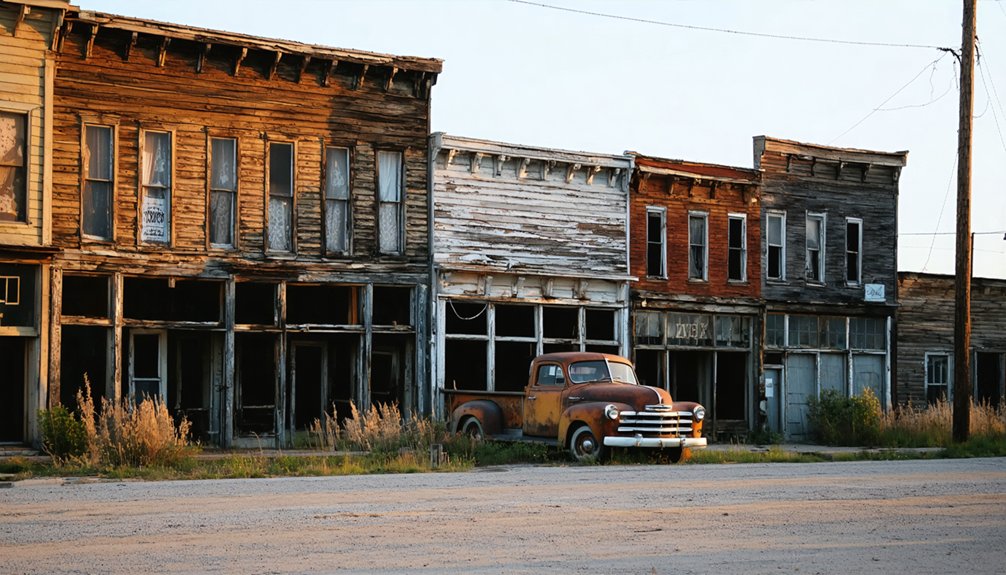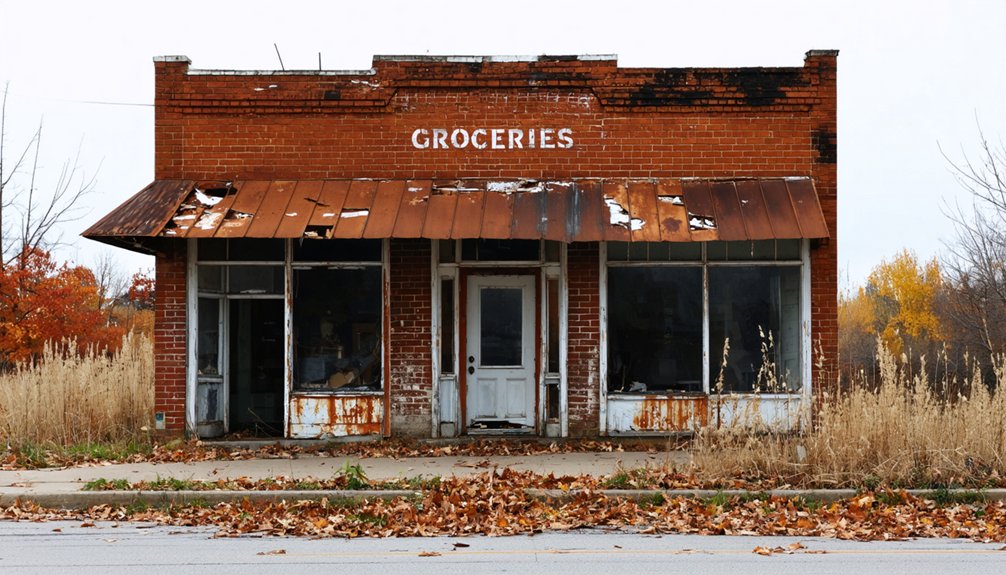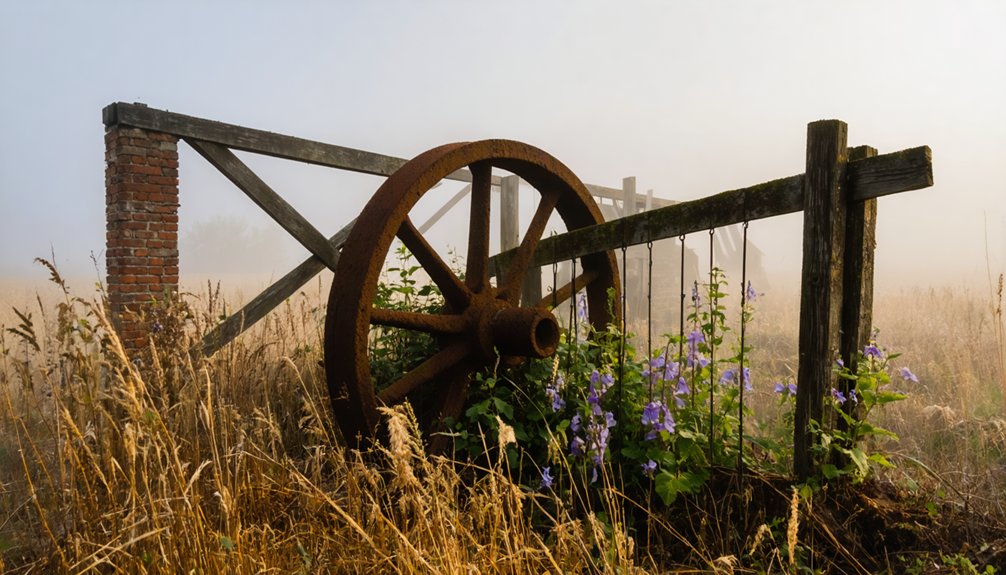You’ll find Bryantsburg located 5 miles north of Independence along Iowa State Highway 150, in the scenic Driftless Area. This ghost town emerged during the prairie colonization era (1833-1920), peaking at 52 residents in 1925 before declining due to agricultural mechanization and reduced railroad importance. Today, the unincorporated community preserves its pioneer spirit through historic property boundaries, old roadways, and a thriving local Amish farming presence. Its untold stories wait within century-old foundations and rural pathways.
Key Takeaways
- Bryantsburg peaked at 52 residents in 1925 before declining due to reduced railroad importance and agricultural mechanization.
- The ghost town’s original layout remains visible through property boundaries and road alignments along Iowa State Highway 150.
- Historic remnants include old roads and cemeteries, serving as physical evidence of the former prairie settlement’s existence.
- The unincorporated community emerged during prairie colonization (1833-1920) and thrived briefly with a post office, bank, and schools.
- Located 5 miles north of Independence, Bryantsburg offers authentic ghost town experiences without commercialized tourist attractions.
A Lost Prairie Settlement
While many Iowa settlements flourished during the great prairie colonization of 1833-1920, Bryantsburg emerged as one of countless temporary communities that dotted the state’s expansive tallgrass landscape.
Like its prairie neighbors, Bryantsburg’s early settlers faced formidable challenges as they ventured from wooded eastern states into unfamiliar open terrain. You’ll find their story mirrors the broader pattern of prairie settlement – starting near the timber’s edge where water and wood were plentiful, then gradually pushing into the prairie interior.
Early prairie settlers crept cautiously from familiar woodlands into vast grasslands, following water and timber before venturing deeper into uncharted territory.
The settler challenges were immense: breaking through dense prairie sod, adapting to unfamiliar soil conditions, and establishing boundaries in the featureless expanse. Coming from an era when 85 percent of Iowa was covered in prairie grasses and wildflowers, these pioneers worked to transform the native landscape into farmland.
Despite the prairie ecology’s inherent fertility, these pioneers struggled initially, having to innovate with materials like osage orange hedges until barbed wire’s arrival in the 1870s.
Location and Geographic Features
Nestled along Iowa State Highway 150 near its junction with 150th Street, Bryantsburg sits approximately 5 miles north of Independence, the Buchanan County seat.
You’ll find this ghost town in the heart of the Driftless Area, where rolling hills and deep valleys create a dramatic landscape unlike Iowa’s typical prairies.
The area’s distinctive topographical features stem from ancient glacial activity, with undulating terrain and remnant oak savannas dotting the countryside.
Within the Wapsipinicon River’s watershed, Bryantsburg’s elevation on higher ground has helped it avoid the flooding that sometimes impacts the region.
While the rural infrastructure has largely disappeared – no more banks, schools, or post offices remain – the land’s rich prairie-derived loams continue supporting agricultural activities beneath the humid continental climate.
Like nearby Shady Grove, Bryantsburg represents one of several historic ghost towns in Buchanan County.
Today, the area’s population includes a significant number of Amish families who maintain traditional farming practices.
The Rise and Fall Timeline
Although Bryantsburg’s origins date to the 19th century, the community’s evolution from a modest flag station to a ghost town spans over 100 years of Iowa history.
You’ll find that its early growth established essential community infrastructure, including a post office, bank, and schools serving the local agricultural population. The town’s population peaked modestly at 52 residents in 1925, sustained by railroad connectivity and farming. Similar to coal mining towns, these small Iowa communities were vulnerable to economic shifts and industry changes. Just like Bryantsburg, Indiana, this town shared not only a name but also the challenges of rural development.
The economic decline began as railroad importance diminished and agricultural patterns shifted. A devastating 1931 hailstorm dealt a significant blow to local farms, while competition from larger towns like Independence drew away residents and businesses.
Early Pioneer Life
As pioneers ventured into Bryantsburg’s territory following the 1832 Black Hawk Purchase, they faced the quintessential challenges of early Iowa settlement.
You’d have found these determined settlers camping along rivers, strategically positioning themselves for both transportation and fertile soil access. Their pioneer struggles included building shelters from whatever materials they could find – often constructing sod houses that provided natural insulation against Iowa’s harsh climate.
The tough soil proved especially challenging, requiring multiple teams of oxen to break through the dense prairie roots.
Community bonds formed quickly as neighbors helped each other build homes and establish farms. Like many areas that would become U.S. counties, the settlement grew through collaborative efforts.
You’d have seen families adapting to their new environment by shifting from wheat to corn production, raising hogs for market, and working together to overcome transportation challenges.
Through ingenuity and cooperation, they transformed the wild prairie into productive farmland, laying the foundation for Bryantsburg’s agricultural heritage.
Remnants of the Past
Today’s visitors to Bryantsburg will find a quiet, unincorporated community along Iowa State Highway 150, where minimal signs of its former liveliness remain visible.
Located at approximately 42.57472°N, 91.90556°W, the settlement’s historical significance lives on through its preserved rural character and surrounding farmland patterns.
While no prominent structures from Bryantsburg’s peak era stand as evidence to its community identity, the town’s original layout can still be traced through existing property boundaries and road alignments.
You’ll notice the area maintains its agricultural heritage, though time has erased many physical reminders of the bustling farming community that once called this place home.
The mechanization of farming contributed significantly to the town’s decline as fewer workers were needed to maintain the surrounding agricultural operations.
Old roads and cemeteries in the area serve as silent reminders of the once-thriving settlement.
Local archives might hold additional clues about the town’s bygone era, but the landscape itself tells the story of rural America’s ever-changing nature.
Agricultural Heritage
The rich agricultural heritage of Bryantsburg mirrors Iowa’s broader farming evolution during the late 19th and early 20th centuries.
You’ll find that local farmers embraced crop diversity through intelligent rotation systems, alternating between corn, oats, and hay to maintain soil health. Like their counterparts across Iowa, Bryantsburg’s farmers adapted to technological changes, incorporating new machinery that transformed their operations. The early adoption of John Deere’s steel plow helped farmers tackle the challenging prairie soil more efficiently.
When agricultural societies promoted sustainable practices, Bryantsburg’s community participated actively in knowledge sharing and innovation.
You can trace how they responded to major historical events – from increasing production during WWI to weathering the Great Depression‘s challenges. The area’s farmers also benefited from vital developments like rural electrification and the introduction of hybrid seeds, though these advancements couldn’t ultimately prevent the town’s decline.
Ghost Town Tourism

While many ghost towns across America have become tourist attractions, Bryantsburg’s remote location and minimal remaining structures have limited its appeal to casual visitors.
You’ll find that unlike popular ghost town tourism destinations that draw international crowds, Bryantsburg remains largely undiscovered by the mainstream tourism industry. This isolation has actually preserved its authentic character during a time when other historic sites struggle with declining visitor numbers.
If you’re planning to explore Bryantsburg, you won’t find guided tours or gift shops like those in commercialized ghost towns.
Instead, you’ll experience a raw, unfiltered glimpse into Iowa’s agricultural past. Local preservation efforts focus on maintaining the site’s historical integrity rather than developing it for mass tourism, making your visitor experience more genuine and meaningful.
Local Amish Community Impact
If you visit Bryantsburg today, you’ll notice how local Amish farmers have adapted the abandoned town’s surrounding fields for traditional horse-drawn plowing and organic cultivation methods.
Their settlement patterns have shifted markedly from the area’s early pioneer days, as Amish families gradually established homesteads along the outskirts of what was once a bustling village center.
The Amish community’s dedication to preserving their agricultural heritage through hands-on teaching and multi-generational farming practices has helped maintain the rural character of this historic landscape.
Amish Farming Practices Today
Modern Amish farming practices near Bryantsburg demonstrate remarkable resilience through sustainable methods and community cooperation.
You’ll find their fields managed through careful crop rotation sequences, where corn gives way to oats, followed by legumes and cover crops. This crop sustainability approach maintains soil health while naturally controlling pests without synthetic chemicals.
The strength of their farming system lies in community cooperation, where neighboring farms share resources, expertise, and labor during essential times like harvest.
They’ve adapted to modern challenges while preserving traditional methods, using organic fertilizers and saving heirloom seeds.
Despite facing economic pressures and climate change impacts, their commitment to gentle farming methods and mutual aid guarantees the land’s significance for future generations, making them critical stewards of Iowa’s agricultural heritage.
Historic Settlement Patterns Changed
The settlement patterns of Iowa’s Amish communities have undergone remarkable changes since their first arrival in 1840, shaping both the cultural and economic landscape around Bryantsburg.
You’ll find that settlement dynamics have evolved from isolated farming communities to more integrated economic networks, while still maintaining their distinct cultural identity.
- Early settlements near Bryantsburg faced challenges with land ownership and progressive influences, causing some communities to dissolve.
- Cultural shifts led to strategic relocation choices, with communities seeking areas that support their conservative church standards.
- Modern Amish settlements have adapted by establishing woodworking shops and farms that contribute to local economies while preserving traditional practices.
Today, you’ll notice how these historic changes continue to influence tourism, cultural exchange, and economic stability in the region, making Bryantsburg’s story part of Iowa’s rich Amish heritage.
Cultural Heritage Preservation Methods
Preserving Bryantsburg’s cultural heritage involves a multi-faceted approach that combines physical conservation, documentation efforts, and the living traditions of local Amish communities.
Through cultural mapping initiatives, you’ll find that historic foundations, old roads, and cemeteries are carefully maintained as tangible links to the past. The local Amish community’s continued practice of traditional farming methods helps protect the rural landscape that once defined Bryantsburg.
Heritage storytelling plays a crucial role, as Amish oral histories provide invaluable insights into early settlement patterns.
You’ll discover that their traditional craftsmanship supports restoration efforts in nearby historic structures. The University of Iowa Digital Library’s collection of maps and documents, combined with ongoing documentation by historians and amateur archaeologists, guarantees that Bryantsburg’s story endures for future generations.
Preserving Bryantsburg’s Memory
While Bryantsburg’s physical structures have largely vanished, passionate local communities and historical societies work diligently to keep its legacy alive through various preservation initiatives.
You’ll find historical artifacts carefully cataloged and preserved, while community storytelling events bring the town’s past to life through shared memories and documented accounts.
- You can explore digital archives that contain maps, photographs, and documents, making Bryantsburg’s history accessible to future generations.
- You’ll discover local volunteer programs that maintain the site and organize educational tours for visitors.
- You’re able to participate in cultural events that celebrate the town’s heritage through historical reenactments and exhibitions.
These preservation efforts guarantee that Bryantsburg’s story continues to inspire and educate, even as its physical presence fades into Iowa’s landscape.
Frequently Asked Questions
Were Any Notable Crimes or Mysteries Reported in Bryantsburg’s History?
You won’t find documented unsolved mysteries or crime history for this location, as historical records are extremely limited. Even deep research into community records reveals no notable criminal incidents.
What Happened to the Original Cemetery and Burial Grounds?
Like 40% of Iowa’s ghost town cemeteries, you won’t find clear records of what happened here. Local historians suggest cemetery relocation occurred, but burial ground preservation efforts haven’t uncovered definitive evidence.
Did Native American Tribes Have Settlements in the Bryantsburg Area?
While tribal history suggests Native American settlement patterns in Iowa, you’ll find no definitive records of specific settlements in Bryantsburg, though tribes likely utilized the area’s resources for hunting and gathering.
What Was the Peak Population of Bryantsburg Before Its Decline?
You’ll find that Bryantsburg’s highest documented population was 52 residents in 1925, marking the peak before demographics shifted toward decline, though earlier numbers showed just 41 people in 1902.
Are There Any Surviving Photographs of Bryantsburg During Its Prime?
You won’t find any confirmed photographs in historical documentation or photographic archives. While local collections might hold undiscovered images, there’s currently no verified surviving photos from Bryantsburg’s prime years.
References
- https://b100quadcities.com/six-ghost-towns-in-iowa/
- https://en.wikipedia.org/wiki/List_of_ghost_towns_in_Iowa
- https://kids.kiddle.co/List_of_ghost_towns_in_Iowa
- https://ouriowaheritage.com/jc-ghost-towns/
- https://reformedjournal.com/2019/07/05/ghost-town-legacy/
- https://pastmaps.com/explore/us/iowa/buchanan-county/bryantsburg/metal-detecting
- https://www.youtube.com/watch?v=eh_YlgRKjBU
- https://www.discoverguthriecounty.org/ghosttowns
- https://pubs.lib.uiowa.edu/annals-of-iowa/article/id/13329/download/pdf/
- https://www.campsilos.org/wp-content/uploads/2021/09/econatres.napc12.dsmith.pdf



